Scotland
| Motto: [Nemo me impune lacessit] Error: {{Lang}}: text has italic markup (help) (Latin) "No one provokes me with impunity" "Cha togar m'fhearg gun dioladh" (Scottish Gaelic) "Wha daur meddle wi me?" (Scots)1 | |
| Anthem: (Multiple unofficial anthems) | |
 Location of Scotland (orange) in Europe (white) | |
| Capital | Edinburgh |
| Largest city | Glasgow |
| Official languages | English (de facto) |
| Recognised regional languages | Gaelic, Scots1 |
| Demonym(s) | Scot, Scots and Scottish² |
| Government | Constitutional monarchy |
• Monarch | Queen Elizabeth II |
| Gordon Brown MP | |
| Alex Salmond MSP | |
| Unification | |
• Lands north of Forth united under Bridei m. Beli | c. 685 |
• Dál Riata incorporated by Óengus m. Fergusa | c. 741 |
| 1124 (confirmed Treaty of York, 1237) | |
• Galloway incorporated | 1234/5 |
| 1472 | |
| Area | |
• Total | 78,772 km2 (30,414 sq mi) |
• Water (%) | 1.9 |
| Population | |
• 2005 estimate | 5,116,900 |
• 2001 census | 5,062,011 |
• Density | 65/km2 (168.3/sq mi) |
| GDP (PPP) | 2006 estimate |
• Total | US$172 billion |
• Per capita | US$33,680 |
| HDI (2003) | 0.939 very high |
| Currency | Pound sterling (GBP) |
| Time zone | UTC0 (GMT) |
• Summer (DST) | UTC+1 (BST) |
| Calling code | 44 |
| ISO 3166 code | GB-SCT |
| Internet TLD | .uk³ |
| |
Scotland (Gaelic: Alba, Scots: Scotland) is a nation in northwest Europe and one of the four constituent countries[3] of the United Kingdom. It occupies the northern third of the island of Great Britain and shares a land border to the south with England. It is bounded by the North Sea to the east, the Atlantic Ocean to the north and west, and the North Channel and Irish Sea to the southwest. Apart from the mainland, Scotland consists of over 790 islands.[4]
Edinburgh, the country's capital and second largest city, is one of Europe's largest financial centres.[5] Scotland's largest city is Glasgow, which is the centre of the Greater Glasgow conurbation. Greater Glasgow is home to approximately 41% of Scotland's population. Scottish waters consist of a large sector[6] of the North Atlantic and the North Sea, containing the largest oil reserves in the European Union.
The Kingdom of Scotland was an independent state until 1 May 1707, when the Acts of Union (despite widespread protest across Scotland)[7] resulted in a union with the Kingdom of England to create the Kingdom of Great Britain.[8][9] Scotland's legal system continues to be separate from those of England, Wales, and Northern Ireland; and Scotland still constitutes a discrete jurisdiction in public and in private law.[10] The continued independence of Scots law, the Scottish education system, and the Church of Scotland have all contributed to the continuation of Scottish culture and Scottish national identity since the Union.[11] However, Scotland is no longer a separate sovereign state and does not have independent membership of either the United Nations or the European Union.
Etymology

Some of the earliest surviving documents to mention the word Scotland include the Anglo-Saxon Chronicles of Abingdon, Worcester and Laud, written during the 11th Century, which state that prior to the Battle of Stamford Bridge in 1066, Earl Tostig had sought refuge in Scotland under the protection of Malcolm III, King of Scots.[12][13] The word Scotland was derived from the Latin Scoti, of uncertain origin, applied to Gaels of Hibernia, the Roman name for modern Ireland. The Late Latin word Scotia (land of the Gaels) was eventually used only of Gaelic-speaking Scotland. This name was employed alongside Albania or Albany, from the Gaelic Alba.[14] The use of the words Scots and Scotland to encompass all of Scotland became common only in the Late Middle Ages.[8] In a modern political context, the word Scot is applied equally to all inhabitants of Scotland, regardless of their ancestral ethnicity. However, a 2006 study published by the University of Edinburgh suggest that segments of Scottish society continue to distinguish between those who claim to be Scots on ethnic grounds and those who claim to be Scots on the grounds of civic commitment.[15] "Scots" is also used to refer to the Scots language, which a large proportion of the Scottish population speak to a greater or lesser degree.[16]
History
Early Scotland
Repeated glaciations, which covered the entire land-mass of modern Scotland, have destroyed any traces of human habitation before the mesolithic period. It is believed that the first post-glacial group(s) of hunter-gatherers arrived in Scotland around 11,000 years ago, as the ice sheet retreated after the last ice age. Groups of settlers began building the first permanent houses on Scottish soil around 9,500 years ago, and the first villages around 6,000 years ago. A site from this period is the well-preserved village of Skara Brae on the Mainland of Orkney. Neolithic habitation, burial and ritual sites are particularly common and well-preserved in the Northern Isles and Western Isles, where lack of trees led to most structures being built of local stone.[17]
The written history of Scotland began with the arrival of the Roman Empire in southern and central Great Britain, when the Romans occupied what is now England and Wales, administering it as a province called Britannia. Roman occupation of Scotland was a series of brief interludes. In 83/4 AD the general Gnaeus Julius Agricola defeated the Caledonians at the battle of Mons Graupius, and Roman forts were briefly set along the Gask Ridge close to the Highland Line (none are known to have ever been constructed beyond that line). Three years after the battle the Roman armies had withdrawn to the Southern Uplands.[18] They erected Hadrian's Wall to control tribes on both sides of the wall,[19] but it effectively became the main northern border for the Romans throughout much of the later occupation of Britain, although they held the Antonine Wall in the Central Lowlands for two short periods. The last of these was during the time of Emperor Septimius Severus from 208 until 210.[20] The extent of Roman occupation of any significant part of Scotland was limited to a total of about 40 years, although their influence on the southern section of the country occupied by Brythonic tribes such as the Votadini and Damnonii would still have been considerable.[19]
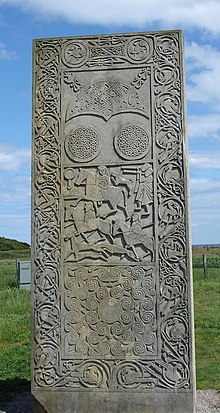
Medieval Scotland
The Kingdom of the Picts (based in Fortriu by the 6th century) was the state which eventually became known as "Alba" or "Scotland". The development of "Pictland", according to the historical model developed by Peter Heather, was a natural response to Roman imperialism.[21] Another view places emphasis on the Battle of Dunnichen, and the reign of Bridei m. Beli (671–693), with another period of consolidation in the reign of Óengus mac Fergusa (732–761).[22] The Kingdom of the Picts as it was in the early 8th century, when Bede was writing, was largely the same as the kingdom of the Scots in the reign of Alexander (1107–1124). However, by the tenth century, the Pictish kingdom was dominated by what we can recognise as Gaelic culture, and had developed an Irish conquest myth around the ancestor of the contemporary royal dynasty, Cináed mac Ailpín (Kenneth MacAlpin).[23]
From a base of territory in eastern Scotland north of the River Forth and south of the River Oykel, the kingdom acquired control of the lands lying to the north and south. By the 12th century, the kings of Alba had added to their territories the English-speaking land in south-east and attained overlordship of Galloway and Norse-speaking Caithness; by the end of the 13th century, the kingdom had assumed approximately its modern borders. However, processes of cultural and economic change beginning in the 12th century ensured Scotland looked very different in the later Middle Ages. The stimulus for this was the reign of King David I and the so-called Davidian Revolution. Feudalism, government reorganisation and the first legally defined towns, called burghs, began in this period. These institutions and the immigration of French and Anglo-French knights and churchmen facilitated a process of cultural osmosis, whereby the culture and language of the low-lying and coastal parts of the kingdom's original territory in the east became, like the newly-acquired south-east, English-speaking, while the rest of the country retained the Gaelic language.[24]
The death of Alexander III in 1286, followed by the death of his grand-daughter Margaret, Maid of Norway, broke the succession line of Scotland's kings. This led to the intervention of Edward I of England. Edward established John Balliol as a sub-king, but this relationship broke down, leading to an ultimately unsuccessful attempt at total takeover by the English crown. This was famously opposed by William Wallace and others in the Wars of Scottish Independence, and in the divided country Robert de Brus, Earl of Carrick, became king (as Robert I). War with England continued for several decades, and a civil war between the Bruce dynasty and the English-backed Balliols lasted until the middle of the 14th century. Although the Bruce dynasty was successful, David II's lack of an heir allowed his nephew Robert II to come to the throne and establish the Stewart Dynasty.[25] The Stewarts ruled Scotland for the remainder of the Middle Ages. The country they ruled experienced greater prosperity from the end of the 14th century through the Scottish Renaissance to the Reformation. This was despite continual warfare with England, the increasing division between Highlands and Lowlands, and a large number of royal minorities.[26]
Modern Scotland

In 1603, James VI King of Scots inherited the throne of the Kingdom of England, and became also King James I of England. With the exception of a short period under The Protectorate, Scotland remained a separate state, but there was considerable conflict between the crown and the Covenanters over the form of church government. After the Glorious Revolution and the overthrow of the Roman Catholic James VII by William and Mary, Scotland briefly threatened to select a different Protestant monarch from England.[27] In 1707, however, following English threats to end trade and free movement across the border, known as the Alien Act, the Scots Parliament and the Parliament of England enacted the twin Acts of Union, which created the Kingdom of Great Britain.[9]
The deposed Jacobite Stuart claimants had remained popular in the Highlands and north-east, particularly amongst non-Presbyterians. However, two major Jacobite risings launched from the Highlands in 1715 and 1745 failed to remove the House of Hanover from the British throne. This paved the way for large scale removals of the indigenous populations of the Highlands and Islands, known as the Highland Clearances.[9]
Following the Scottish Enlightenment and the Industrial Revolution, Scotland became one of the commercial, intellectual and industrial powerhouses of Europe. After World War II, Scotland experienced an industrial decline which was particularly severe.[28] Only in recent decades has the country enjoyed something of a cultural and economic renaissance. Factors which have contributed to this recovery include a resurgent financial services and electronics sector (see Silicon Glen), and the proceeds of North Sea oil and gas.[29] The Scottish Parliament was established by the UK government under the Scotland Act 1998.
Politics

As one of the constituent countries of the United Kingdom, the head of state in Scotland is the British monarch, currently Queen Elizabeth II (since 1952). (In Scotland, the title Queen Elizabeth II is controversial, as there has never been an Elizabeth I in Scotland.)[30] Constitutionally the United Kingdom is a unitary state with one sovereign parliament and government. Under a system of devolution (or home rule) Scotland was granted limited self-government after a referendum on devolution proposals in 1997. The British Parliament in Westminster retains the ability to amend, change, broaden or abolish the devolved government system at will. As such the Scottish Parliament is not sovereign.
Executive power in the United Kingdom is vested in the Queen-in-Council, while legislative power is vested in the Queen-in-Parliament (the Crown and the Parliament of the United Kingdom at Westminster in London). Under devolution executive and legislative powers in certain areas have been constitutionally delegated to the Scottish Government and the Scottish Parliament at Holyrood in Edinburgh respectively. The United Kingdom Parliament retains active power over Scotland's taxes, social security system, the military, international relations, broadcasting, and some other areas explicitly specified in the Scotland Act 1998 as reserved matters.[31]
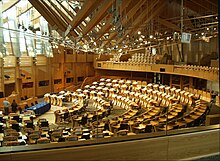
The Scottish Parliament has legislative authority for all other areas relating to Scotland, and has limited power to vary income tax but has never exercised this power. The Scottish Parliament can refer devolved matters back to Westminster to be considered as part of United Kingdom-wide legislation by passing a Legislative Consent Motion if United Kingdom-wide legislation is considered to be more appropriate for certain issues. The programmes of legislation enacted by the Scottish Parliament have seen a divergence in the provision of public services compared to the rest of the United Kingdom. For instance, the costs of a university education, and care services for the elderly are free at point of use in Scotland, while fees are paid in the rest of the UK. Scotland was the first country in the UK to ban smoking in public places.[32]
The Scottish Parliament is a unicameral legislature comprising 129 Members, 73 of whom represent individual constituencies and are elected on a first past the post system; 56 are elected in eight different electoral regions by the additional member system, first elected on the May 6 1999 and serving for a four year period. The Queen appoints one Member of the Scottish Parliament, (MSP), on the nomination of the Parliament, to be First Minister. Other Ministers are also appointed by the Queen on the nomination of the Parliament and together with the First Minister they make up the Scottish Government, the executive arm of government.[33]
In the 2007 election, the Scottish National Party (SNP), which campaigns for Scottish independence, won the greatest number seats of any single party. The leader of the SNP, Alex Salmond, was elected as First Minister of a minority government on May 16 2007. In addition to the SNP, the Labour Party, led by Wendy Alexander, the Conservative Party, led by Annabelle Goldie, the Liberal Democrats, led by Nicol Stephen and the Green Party, co-led by Robin Harper, are also represented in the Parliament. In addition Margo MacDonald is the only independent MSP sitting in Parliament.[34]
Scotland is represented in the British House of Commons by 59 MPs elected from territory-based Scottish constituencies. The Scotland Office, a department of the United Kingdom government led by The Secretary of State for Scotland, is responsible for reserved matters. The Secretary of State for Scotland sits in the Cabinet of the United Kingdom, the current incumbent being Des Browne.[31]
Law

Scots law has a basis derived from Roman law,[35] combining features of both uncodified civil law, dating back to the Corpus Juris Civilis, and common law with mediaeval sources. The terms of the Treaty of Union with England in 1707 guaranteed the continued existence of a separate legal system in Scotland from that of England and Wales.[36] Prior to 1611, there were several regional law systems in Scotland, most notably Udal law in Orkney and Shetland, based on old Norse law. Various other systems derived from common Celtic or Brehon laws survived in the Highlands until the 1800s.[37]
Scots law provides for three types of courts responsible for the administration of justice: civil, criminal and heraldic. The supreme civil court is the Court of Session, although civil appeals can be taken to the House of Lords. The High Court of Justiciary is the supreme criminal court. Both courts are housed at Parliament House, in Edinburgh, which was the home of the pre-Union Parliament of Scotland. The sheriff court is the main criminal and civil court. There are 49 sheriff courts throughout the country.[38] District courts were introduced in 1975 for minor offences. The Court of the Lord Lyon regulates heraldry.
Scots law is also unique in that it allows three verdicts in criminal cases including the controversial 'not proven' verdict.[39][40]
Administrative subdivisions

Historical subdivisions of Scotland include the mormaerdom, stewartry, earldom, burgh, parish, county and regions and districts. The names of these areas are still sometimes used as geographical descriptors.
Modern Scotland is subdivided in various ways depending on the purpose. For local government, 32 council areas were set up in 1996,[41] which are administered by unitary authorities responsible for the provision of all local government services. Community councils are informal organisations that represent specific sub-divisions of a council area.
For the Scottish Parliament, there are 73 constituencies and eight regions. For the Parliament of the United Kingdom there are 59 constituencies. The Scottish fire brigades and police forces are still based on the system of regions introduced in 1975. For health-care and postal districts, and a number of other governmental and non-governmental organisations such as the churches, there are other long-standing methods of subdividing Scotland for the purposes of administration.
City status in the United Kingdom is determined by letters patent.[42] There are six cities in Scotland: Aberdeen, Dundee, Edinburgh, Glasgow and more recently Inverness, and Stirling.[43]
Geography and natural history

Scotland comprises the northern third of the island of Great Britain, which lies off the coast of north west Europe. The total land mass is 78,772 km² (30,414 mi²).[44] Scotland's only land border is with England, and runs for 96 kilometres (60 miles) between the River Tweed on the east coast and the Solway Firth in the west. The Atlantic Ocean borders the west coast and the North Sea is to the east. The island of Ireland lies only 30 kilometres (20 mi) from the south western peninsula of Kintyre, Norway is 400 kilometres (250 mi) to the north east, the Faroes 310 kilometres (193 mi) and Iceland 798 km (496 mi) to the north west. The geographical centre of Scotland lies a few miles from the village of Newtonmore in Badenoch, far to the north of the modern population heartlands.[45]
The territorial extent of Scotland is generally that established by the 1237 Treaty of York between Scotland and England[46] and the 1266 Treaty of Perth between Scotland and Norway.[9] Exceptions include: the Isle of Man, which is now a crown dependency outside the United Kingdom, the 15th century acquisitions of Orkney and Shetland from Norway;[44] and Rockall, a small rocky islet in the North Atlantic which was annexed by the UK in 1955 and later declared part of Scotland by the Island of Rockall Act 1972.[47][48] However, the legality of the claim is disputed by the Republic of Ireland, Denmark and Iceland and it is probably unenforceable in international law.[49][50]
Geology and geomorphology

The whole of Scotland was covered by ice sheets during the Pleistocene ice ages and the landscape is much affected by glaciation. From a geological perspective the country has three main sub-divisions. The Highlands and Islands lie to the north and west of the Highland Boundary Fault, which runs from Arran to Stonehaven. This part of Scotland largely comprises ancient rocks from the Cambrian and Precambrian which were uplifted during the later Caledonian Orogeny. These foundations are interspersed with many igneous intrusions of a more recent age, the remnants of which have formed mountain massifs such as the Cairngorms and Skye Cuillins. A significant exception to the above are the fossil-bearing beds of Old Red Sandstones found principally along the Moray Firth coast. The Highlands are generally mountainous and are bisected by the Great Glen. The highest elevations in the British Isles are found here, including Ben Nevis, the highest peak at 1,344 metres (4,409 ft). Scotland has over 790 islands, divided into four main groups: Shetland, Orkney, and the Hebrides, sub-divided into the Inner Hebrides and Outer Hebrides. There are numerous bodies of freshwater including Loch Lomond and Loch Ness. Some parts of the coastline consist of machair, a low lying dune pasture land.
The Central Lowlands is a rift valley mainly comprising Paleozoic formations. Many of these sediments have economic significance for it is here that the coal and iron bearing rocks that fuelled Scotland's industrial revolution are to be found. This area has also experienced intense volcanism, Arthur’s Seat in Edinburgh being the remnant of a once much larger volcano active in the Carboniferous period some 300 million years ago. Also known as the Midland Valley, this area is relatively low-lying, although even here hills such as the Ochils and Campsie Fells are rarely far from view.
The Southern Uplands are a range of hills almost 200 km (125 miles) long, interspersed with broad valleys. They lie south of a second fault line running from Stranraer towards Dunbar. The geological foundations largely comprise Silurian deposits laid down some 4–500 million years ago.[8][51][52]
Climate
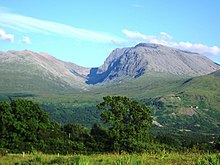
The climate of Scotland is temperate and oceanic, and tends to be very changeable. It is warmed by the Gulf Stream from the Atlantic, and as such has much milder winters (but cooler, wetter summers) than areas on similar latitudes, for example Copenhagen, Moscow, or the Kamchatka Peninsula on the opposite side of Eurasia. However, temperatures are generally lower than in the rest of the UK, with the coldest ever UK temperature of -27.2 °C (-16.96 °F) recorded at Braemar in the Grampian Mountains, on 11 February 1895 and 10 January 1982 and also at Altnaharra, Highland, on 30 December 1995.[53] Winter maximums average 6 °C (42.8 °F) in the lowlands, with summer maximums averaging 18 °C (64.4 °F). The highest temperature recorded was 32.9 °C (91.22 °F) at Greycrook, Scottish Borders on 9 August 2003.[54]
In general, the west of Scotland is usually warmer than the east, due to the influence of the Atlantic ocean currents, and the colder surface temperatures of the North Sea. Tiree, in the Inner Hebrides, is one of the sunniest places in the country: it had 300 days of sunshine in 1975. Rainfall varies widely across Scotland. The western highlands of Scotland are the wettest place, with annual rainfall exceeding 3,000 mm (120 inches).[54] In comparison, much of lowland Scotland receives less than 800 mm (31 inches) annually.[54] Heavy snowfall is not common in the lowlands, but becomes more common with altitude. Braemar experiences an average of 59 snow days per year,[55] while coastal areas have an average of fewer than 10 days.[54]
Flora and fauna
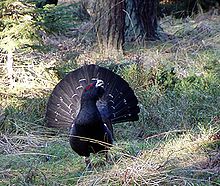
Scotland's wildlife is typical of the north west of Europe, although several of the larger mammals such as the Brown Bear, Wolf, Eurasian Lynx, Beaver, Reindeer, Elk and Walrus were hunted to extinction in historic times. There are important populations of seals and internationally significant nesting grounds for a variety of seabirds such as Northern Gannets.[56] The Golden Eagle is something of a national icon, with White-tailed Eagles, Ospreys and Red Kites being recent re-introductions following persecution to the point of extinction.
A population of Snow Bunting summers on the high mountain tops and at such elevations species including Ptarmigan, Mountain Hare and Stoat can be seen in their white colour phase during winter months.[57] Remnants of native Scots Pine forest exist[58] and within these areas the Scottish Crossbill, Britain's only endemic bird, can be found alongside Capercaillie and Black Grouse.[59] The Wildcat, Red Squirrel and Pine Marten also favour this habitat.[60]
The flora of the country is varied incorporating both deciduous and coniferous woodland and moorland and tundra species. However, large scale commercial planting of non-native coniferous tree species and the management of upland moorland habitat for the grazing of sheep and commercial field sport activities, (principally the stalking of Red Deer and shooting of Red Grouse),[61] impacts upon the distribution of indigenous plants and animals. The Fortingall Yew may be 5,000 years old and is probably the oldest living thing in Europe.[62]
Economy

Scotland has a western style open mixed economy which is closely linked with that of the rest of Europe and the wider world. Traditionally, the Scottish economy has been dominated by heavy industry underpinned by the shipbuilding, coal mining and steel industries. Petroleum related industries associated with the extraction of North Sea oil have also been important employers from the 1970s, especially in the north east of Scotland. De-industrialisation during the 1970s and 1980s saw a shift from a manufacturing focus towards a more services orientated economy. Edinburgh is the financial services centre of Scotland and the sixth largest financial centre in Europe in terms of funds under management, behind London, Paris, Frankfurt, Zurich and Amsterdam,[63] with many large finance firms based there, including: the Royal Bank of Scotland (the second largest bank in Europe); HBOS (owners of the Bank of Scotland); and Standard Life.
In 2005, total Scottish exports (excluding intra-UK trade) were provisionally estimated to be £17.5 billion, of which 70% (£12.2 billion) were attributable to manufacturing.[64] Scotland's primary exports include whisky, electronics and financial services. The United States, The Netherlands, Germany, France and Spain constitute the country's major export markets.[64] In 2006, the Gross Domestic Product (GDP) of Scotland was just over £86 billion, giving a per capita GDP of £16 900. [65][66]
Tourism is widely recognised as a key contributor to the Scottish economy. A briefing published in 2002 by the Scottish Parliament Information Centre, (SPICe), for the Scottish Parliament's Enterprise and Life Long Learning Committee, stated that tourism accounted for up to 5% of GDP and 7.5% of employment. [67]
As of 2006, the unemployment rate in Scotland stood at 5.1% - marginally above the UK average, but lower than in the majority of EU countries.[68]
Currency
Although the Bank of England is the central bank for the UK, three Scottish clearing banks still issue their own Sterling banknotes: the Bank of Scotland; the Royal Bank of Scotland; and the Clydesdale Bank. These notes have no status as legal tender anywhere in the United Kingdom, although they are fungible with the Bank of England banknotes.[69] Despite this, Scottish-issued notes are sometimes refused in England and are not always accepted by banks and exchange bureaus outside the UK. The Royal Bank of Scotland still produces a £1 note.[70] The current value of the Scottish banknotes in circulation is £1.5 billion.[69]
Demographics

The population of Scotland in the 2001 census was 5,062,011. This has risen to 5,116,900 according to June 2006 estimates.[71] This would make Scotland the 112th largest country by population if it were a sovereign state. Although Edinburgh is the capital of Scotland it is not the largest city. With a population of just over 600,000 this honour falls to Glasgow. Indeed, the Greater Glasgow conurbation, with a population of over 1.1 million, is home to over a fifth of Scotland's population.[72][73]
The Central Belt is where most of the main towns and cities are located. Glasgow is to the west whilst the other three main cities of Edinburgh, Aberdeen and Dundee lie on the east coast. The Highlands are sparsely populated although the city of Inverness has experienced rapid growth in recent years. In general only the more accessible and larger islands retain human populations and fewer than 90 are currently inhabited. The Southern Uplands are essentially rural in nature and dominated by agriculture and forestry.[74][75] Because of housing problems in Glasgow and Edinburgh, five new towns were created between 1947 and 1966. They are East Kilbride, Glenrothes, Livingston, Cumbernauld, and Irvine.[76]
Due to immigration since World War II, Glasgow, Edinburgh and Dundee have significant ethnically Asian populations.[77] Since the recent Enlargement of the European Union there has been an increased number of people from Central and Eastern Europe moving to Scotland, and it is estimated that between 40,000 and 50,000 Poles are now in living in the country.[78] As of 2001, there are 16,310 ethnic Chinese residents in Scotland.[79]
Scotland has three officially recognised languages: English, Scots and Scottish Gaelic. Almost all Scots speak Scottish Standard English, and in 1996 the General Register Office for Scotland estimated that 30% of the population are fluent in Scots.[80] Gaelic is mostly spoken in the Western Isles, where a majority of people still speak it, however nationally its use is confined to just 1% of the population.[81]
Religion

Since the distinctive Scottish Reformation of 1560, the Church of Scotland, also known as The Kirk, has been Scotland's national church. The Church is Protestant and Reformed, and unlike the Church of England, it has a Presbyterian system of church government, and enjoys independence from the state.[8] About 12% of the Scottish population are currently members of the Church of Scotland, with around 40% of the population claiming affiliation at the 2001 census. The Church operates a territorial parish structure, with every community in Scotland having a local congregation. Scotland also has a significant Roman Catholic population, particularly in the west. After the Reformation, Roman Catholicism continued on in the Highlands and some western islands like Uist and Barra, and was strengthened, during the 19th century by immigration from Ireland. Other Christian denominations in Scotland include the Free Church of Scotland, various other presbyterian offshoots, and the Scottish Episcopal Church. Islam is the largest non-Christian religion (estimated at 50,000, which is less than 1% of the population),[82] and there are also significant Jewish, Hindu and Sikh communities, especially in Glasgow. In the 2001 census, 28% of the population professed 'no religion' whatsoever.[82]
Military
Although Scotland has a long military tradition that predates the Act of Union with England, its armed forces now form part of the British Armed Forces, with the notable exception of the Atholl Highlanders, Europe's only legal private army. In 2006, the regiments of the Scottish Division were amalgamated to form the Royal Regiment of Scotland.
Due to their topography and perceived remoteness, parts of Scotland have housed many sensitive defence establishments, with mixed public feelings.[83][84] Between 1960 and 1991, the Holy Loch was a base for the U.S. fleet of Polaris ballistic missile submarines.[85] Today, Her Majesty's Naval Base Clyde, 25 miles (40 km) west of Glasgow, is the base for the four Trident-armed Vanguard class ballistic missile submarines that comprise the UK's nuclear deterrent. HMS Caledonia at Rosyth in Fife is the support base for navy operations in Scotland and also serves as the Naval Regional Office (NRO Scotland and Northern Ireland). The Royal Navy's submarine nuclear reactor development establishment is located at Dounreay, which was also the site of the UK's fast breeder nuclear reactor programme. HMS Gannet is a search and rescue station based at Prestwick Airport in Ayrshire and operates three Sea King Mk 5 helicopters. RM Condor at Arbroath, Angus is home to 45 Commando, Royal Marines.[86]
Three frontline Royal Air Force bases are also located in Scotland. These are RAF Lossiemouth, the RAF's primary base for the Panavia Tornado GR4 strike aircraft, RAF Kinloss, home to the Nimrod maritime patrol aircraft, and RAF Leuchars, the most northerly air defence fighter base in the United Kingdom and home to three squadrons of Panavia Tornado F3 aircraft. The "Scottish Air Traffic Control Centre (Military)" is located at RAF Prestwick, in Ayrshire.
The only open air live depleted uranium weapons test range in the British Isles is located near Dundrennan.[87] As a result, over 7000 radioactive munitions lie on the seabed of the Solway Firth.[88] The large number of military bases in Scotland has led some to use the euphemism "Fortress Scotland".[89] In 2005, the MoD land holdings in Scotland (owned, leased or with legal rights) was 115,300 hectares representing 31.5% of the MoD's UK estate.[90]
Education
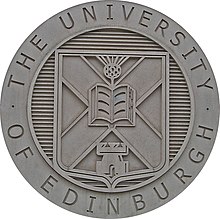
The Scottish education system has always remained distinct from education in the rest of United Kingdom, with a characteristic emphasis on a broad education.[91] Scotland was the first country since Sparta in classical Greece to implement a system of general public education.[92] Schooling was made compulsory for the first time in Scotland with the Education Act of 1496, then, in 1561, the Kirk set out a national programme for spiritual reform, including a school in every parish. Education continued to be a matter for the church rather than the state until the Education Act of 1872.[93]
All 3 and 4 year old children in Scotland are entitled to a free nursery place with "a curriculum framework for children 3-5"[94] providing the curricular guidelines. Formal primary education begins at approximately 5 years old and lasts for 7 years (P1-P7); The "5-14 guidelines" provides the curricular framework.[95] Today, children in Scotland sit Standard Grade exams at approximately 15 or 16. The school leaving age is 16, after which students may choose to remain at school and study for Access, Intermediate or Higher Grade and Advanced Higher exams. A small number of students at certain private, independent schools may follow the English system and study towards GCSEs instead of Standard Grades, and towards A and AS-Levels instead of Higher Grade and Advanced Higher exams.[96]
There are 14 Scottish universities, some of which are amongst the oldest in the world.[97][98] The country produces 1% of the world's published research with less than 0.1% of the world's population, and higher education institutions account for nine per cent of Scotland's service sector exports.[99][100]
Culture
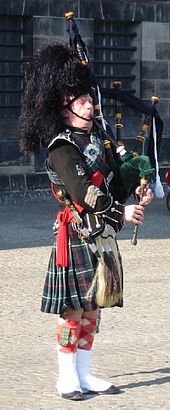
Over the course of many centuries, an amalgamation of various traditions has moulded the culture of Scotland. There is a robust arts scene, with both music and literature heavily influenced by Scottish sources and a variety of national media outlets. Several Scottish sporting traditions are unique to the British Isles, and co-exist with more popular games such as football and rugby.
The Scottish music scene is a significant aspect of Scottish culture, with both traditional and modern influences. An example of a traditional Scottish instrument is the Great Highland Bagpipe, a wind instrument consisting of one or more musical pipes which are fed continuously by a reservoir of air in a bag. The Clàrsach, fiddle and accordion are also traditional Scottish instruments, the latter two heavily featured in Scottish country dance bands. Scottish emigrants took traditional Scottish music with them and it influenced early local styles such as country music in North America. Today, there are many successful Scottish bands and individual artists in varying styles.[101]
Scottish literature includes text written in English, Scottish Gaelic, Scots, French, and Latin. The poet and songwriter Robert Burns wrote in the Scots language, although much of his writing is also in English and in a "light" Scots dialect which is more accessible to a wider audience. Similarly, the writings of Sir Walter Scott and Arthur Conan Doyle were internationally successful during the late 19th and early 20th Centuries.[102] J. M. Barrie introduced the movement known as the "kailyard tradition" at the end of the 19th century, which brought elements of fantasy and folklore back into fashion.[103] This tradition has been viewed as a major stumbling block for Scottish literature, as it focused on an idealised, pastoral picture of Scottish culture.[103] Some modern novelists, such as Irvine Welsh (of Trainspotting fame), write in a distinctly Scottish English that reflects the harsher realities of contemporary life.[104]
The national broadcaster is BBC Scotland (BBC Alba in Gaelic), a constituent part of the British Broadcasting Corporation, the publicly-funded broadcaster of the United Kingdom. It runs two national television stations and the national radio stations, BBC Radio Scotland and BBC Radio nan Gaidheal amongst others. The main Scottish commercial television stations are STV and Border Television. National newspapers such as the Daily Record, The Herald, and The Scotsman are all produced in Scotland.[105] Important regional dailies include The Courier in Dundee in the east, and The Press and Journal serving Aberdeen and the north.[105]
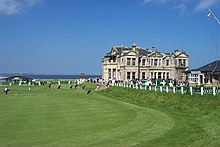
Sport is an important element in Scottish culture, with the country hosting many of its own national sporting competitions, and enjoying independent representation at many international sporting events such as the FIFA World Cup, the Rugby World Cup and the Commonwealth Games (although not the Olympic Games). Scotland has its own national governing bodies, such as the Scottish Football Association (the second oldest national football association in the world)[106] and the Scottish Rugby Union. Variations of football have been played in Scotland for centuries with the earliest reference being in 1424.[107] Association football is now the national sport and the Scottish Cup is the world's oldest national trophy.[108] The Fife town of St. Andrews is known internationally as the Home of Golf[109]and to many golfers the Old Course, an ancient links course dating to before 1574, is considered to be a site of pilgrimage.[110] There are many other famous golf courses in Scotland, including Carnoustie, Gleneagles, Muirfield and Royal Troon. Other distinctive features of the national sporting culture include the Highland games, curling and shinty. Scotland played host to the Commonwealth Games in 1970 and 1986.
Transport
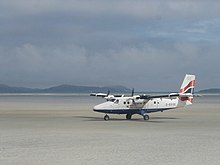
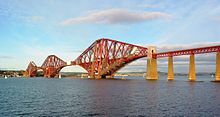
Scotland has five main international airports (Glasgow, Edinburgh, Aberdeen, Prestwick and Inverness Airport) which together serve 150 international destinations with a wide variety of scheduled and chartered flights.[111] Highland and Islands Airports operate 10 regional airports serving the more remote locations of Scotland.[112] There is technically no national airline, however various airlines have their base in Scotland including Loganair (operates as a franchise of British Airways), bmi regional[113] Flyglobespan, City Star Airlines, and ScotAirways.
Scotland has a large and expanding rail network, which, following the Railways Act of 2005, is now managed independently from the rest of the UK by Transport Scotland.[114] The East Coast and West Coast Main Railway lines and the Cross Country Line connect the major cities and towns of Scotland with the English network. First ScotRail operate services within Scotland. The Scottish Executive has pursued a policy of building new railway lines, and reopening closed ones. Operators to English destinations include First ScotRail, GNER and Virgin Trains.
The Scottish motorways and major trunk roads are managed by Transport Scotland. The rest of the road network is managed by the Scottish local authorities in each of their areas. The country's busiest motorway is the M8 which runs from the outskirts of Edinburgh to central Glasgow, and on to Renfrewshire.[115]
Regular ferry services operate between the Scottish mainland and island communities. These services are mostly run by Caledonian MacBrayne, but some are operated by local councils. Other ferry routes, served by multiple companies, connect to Northern Ireland, Belgium, Norway, the Faroe Islands and also Iceland.
National symbols
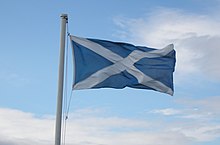
The Flag of Scotland, known as the Saltire or St. Andrew's Cross, dates (at least in legend) from the 9th century, and is thus the oldest national flag still in use. The Saltire now also forms part of the design of the Union Flag. There are numerous other symbols and symbolic artefacts, both official and unofficial, including the thistle, the nation's floral emblem, the 1320 statement of political independence the Declaration of Arbroath, the textile pattern tartan that often signifies a particular Scottish clan, and the Lion Rampant flag.[116][117][118]
Flower of Scotland is popularly held to be the National Anthem of Scotland, and is played at international events such as football or rugby matches involving the Scotland national team. However, since devolution, more serious discussion of a national anthem has led to this being disputed. Other candidates include Scots Wha Hae, Scotland the Brave and A Man's A Man for A' That.[119]
St Andrew's Day, 30 November, is the national day, although Burns' Night tends to be more widely observed. Tartan Day is a recent innovation from Canada. In 2006, the Scottish Parliament passed the St. Andrew's Day Bank Holiday (Scotland) Act 2007, designating the day to be an official bank holiday.[120]
See also
References
- ^ "European Charter for Regional or Minority Languages" Scottish Government. Retrieved 27 September 2007.
- ^ Macleod, Angus "Gaelic given official status" (22 April 2005) The Times. London. Retrieved 02 August 2007.
- ^ "Welcome to the UK" 10 Downing Street. The website of the Prime Minister of the United Kingdom, which refers to "Countries within a country", stating "The United Kingdom is made up of four countries: England, Scotland, Wales and Northern Ireland". Retrieved on 21 September 2007.
- ^ "Scottish Executive Resources" (PDF). Scotland in Short. Scottish Executive. 17 February 2007. Retrieved September 14.
{{cite web}}: Check date values in:|accessdate=and|date=(help); Unknown parameter|accessyear=ignored (|access-date=suggested) (help) - ^ "Information for Journalists". Edinburgh, Inspiring Capital. Edinburghbrand.com. Retrieved 2007-09-20. "Edinburgh is Europe's sixth largest fund management centre".
- ^ "The Scottish Adjacent Waters Boundaries Order". London: The Stationery Office Limited. 1999. ISBN 0 11 059052 X. Retrieved 2007-09-20.
- ^ Devine, T.M (1999) The Scottish Nation 1700–2000. Penguin Books. Page 9. ISBN 0-14-023004-1 "From that point on anti-union demonstrations were common in the capital. In November rioting spread to the south west, that stranglehold of strict Calvinism and covenanting tradition. The Glasgow mob rose against union sympathisers in disturbances which lasted intermittently for over a month"
- ^ a b c d Keay, J. & Keay, J. (1994) Collins Encyclopaedia of Scotland. London. HarperCollins.
- ^ a b c d Mackie, J.D. (1969) A History of Scotland. London. Penguin.
- ^ Collier, J.G. (2001) Conflict of Laws (Third edition)(pdf) Cambridge University Press. "For the purposes of the English conflict of laws, every country in the world which is not part of England and Wales is a foreign country and its foreign laws. This means that not only totally foreign independent countries such as France or Russia... are foreign countries but also British Colonies such as the Falkland Islands. Moreover, the other parts of the United Kingdom - Scotland and Northern Ireland - are foreign countries for present purposes, as are the other British Islands, the Isle of Man, Jersey and Guernsey."
- ^ Devine, T.M (1999), The Scottish Nation 1700–2000, P.288–289, ISBN 0-14-023004-1 "created a new and powerful local state run by the Scottish bourgeoisie and reflecting their political and religious values. It was this local state, rather than a distant and usually indifferent Westminster authority, that in effect routinely governed Scotland"
- ^ Swanton, M. (2000) The Anglo-Saxon Chronicles. London. Phoenix Press. Quoted by bbc.co.uk. Retrieved 14 October 2007.
- ^ "The Anglo-Saxon Chronicles" Source: Garmonsway, G.N. (1994) The Anglo-Saxon Chronicle. Everyman. Retrieved 14 October 2007.
- ^ Ayto, John. Brewer's Britain & Ireland : The History, Culture, Folklore and Etymology of 7500 Places in These Islands. WN. ISBN 030435385X.
{{cite book}}: Unknown parameter|coauthors=ignored (|author=suggested) (help) - ^ Institute of Governance Identity Briefing "Who is Scottish? Political arguments, popular understandings and the implications for social inclusion. Briefing No. 14. January 2006" Retrieved 14 Oct 2007
- ^ " Initial Periodical report presented to the Secretary General of the Council of Europe in Accordance with Article 15 of the Charter" (pdf) European Charter for Regional or Minority Languages. (01/07/2002). Part 1, Section 3 states "However, surveys have indicated that 30% of respondents said they could speak Scots; a large proportion of the Scottish population speak Scots to a greater or lesser degree. Scots is on a linguistic continuum with English. Many Scots literally switch between English and Scots in mid-sentence by using Scots words and Scottish grammar". Retrieved on 26 September 2007.
- ^ Pryor, Francis, Britain BC, (London, 2003), pp. 98–104 & 246–250.
- ^ Hanson, William S. The Roman Presence: Brief Interludes, in Edwards, Kevin J. & Ralston, Ian B.M. (Eds) (2003) Scotland After the Ice Age: Environment, Archeology and History, 8000 BC - AD 1000. Edinburgh. Edinburgh University Press
- ^ a b Snyder, Christopher A. (2003), The Britons, Blackwell Publishing, ISBN 0-631-22260-X
- ^ Robertson, Anne S. (1960) The Antonine Wall. Glasgow Archaeological Society.
- ^ Peter Heather, "State Formation in Europe in the First Millennium A.D.", in Barbara Crawford (ed.), Scotland in Dark Ages Europe, (Aberdeen, 1994), pp. 47–63
- ^ For instance, Alex Woolf, "The Verturian Hegemony: a mirror in the North", in M. P. Brown & C. A. Farr, (eds.), Mercia: an Anglo-Saxon Kingdom in Europe, (Leicester, 2001), pp. 106–11.
- ^ Dauvit Broun, "Dunkeld and the origin of Scottish identity", in Innes Review, 48 (1997), pp. 112–124, repr. in eds. Dauvit Broun and Thomas Owen Clancy (eds.), Spes Scotorum: Hope of Scots, (1999), pp. 95–111; Dauvit Broun, "Kenneth mac Alpin", in M. Lynch (ed.), The Oxford Companion to Scottish History, (New York, 2001), p.359; Sally Foster, Picts, Gaels and Scots: Early Historic Scotland, (London, 1996); Simon Taylor, "Place-names and the Early Church in Eastern Scotland", in Barbara Crawford (ed.), Scotland in Dark Age Britain, (Aberdeen, 1996), pp. 93–110; David N. Dumville, "St Cathróe of Metz and the Hagiography of Exoticism," in John Carey et al (eds.), Irish Hagiography: Saints and Scholars, (Dublin, 2001), pp. 172–176; Maire, Herbert, "Rí Érenn, Rí Alban, kingship and identity in the ninth and tenth centuries", in Simon Taylor (ed.), Kings, Clerics and Chronicles in Scotland, 500–1297, (Dublin, 2000), pp. 63–72.
- ^ The only extensive study of this is L. W. Sharp, The Expansion of the English Language in Scotland, (Cambridge University Ph.D. thesis, 1927), pp. 102–325; another more concise and more recent survey can be found in Derick S. Thomson, Gaelic in Scotland, 1698–1981, (Edinburgh, 1984), pp. 16–41; the best place to look for studies of the transformation of Gaelic institutions will be the two collections of essays by G.W.S. Barrow, The Kingdom of the Scots, 2nd Edn, (Edinburgh, 2003) and Scotland and Its Neighbours In the Middle Ages, (London, 1992); see also Dauvit "Broun, Anglo-French acculturation and the Irish element in Scottish Identity", in Brendan Smith (ed.), Insular Responses to Medieval European Change, (Cambridge, 1999), pp. 135–53; Wilson MacLeod, Divided Gaels: Gaelic Cultural Identities in Scotland and Ireland: c.1200–1650, (Oxford, 2004), and Thomas Owen Clancy. "Gaelic Scotland: a brief history". Bòrd na Gàidhlig. Retrieved 2007-09-21..
- ^ For accounts of these events, see Alexander Grant, Independence and Nationhood: Scotland, 1306–1469, (Edinburgh, 1984), pp. 3–57; Michael Brown, The Wars of Scotland, 1214–1371, (Edinburgh, 2004), pp. 157–254; G. W. S. Barrow, Robert Bruce & the Community of the Realm of Scotland, 4th Edition, (Edinburgh, 2005)
- ^ See Alexander Grant, Independence and Nationhood: Scotland, 1306–1469, (Edinburgh, 1984) and Jenny Wormald, Court, Kirk and Community, New Edition, (Edinburgh, 1991).
- ^ TM Devine (1999) op cit "...Stated that the Scots Parliament had the right to decide on Queen Anne's successor, and that England and Scotland could not have the same sovereign in the future unless the London Parliament granted Scots 'Free Communication of trade'..."
- ^ Harvie, Christopher (1981) No Gods and Precious Few Heroes: Scotland 1914-80. London. Edward Arnold.
- ^ See Stewart, Heather, "Celtic Tiger Burns Brighter at Holyrood, The Guardian Unlimited, 6 May 2007 for an account of Scotland's economic challenges, especially after the dotcom downturn, as it competes with the emerging Eastern European economies.
- ^ In a rare act of sabotage, new Royal Mail post boxes in Scotland, bearing the initials "E II R", were vandalised. (Prior to Queen Elizabeth II, Scottish boxes had borne the monarch's initials, but no crown.) To avoid further problems, post boxes and Royal Mail vehicles in Scotland now bear only the Crown of Scotland and no Royal Cypher. A legal case, MacCormick v. Lord Advocate (1953 SC 396), was taken to contest the right of the Queen to style herself Elizabeth II within Scotland, arguing that to do so would be a breach of the Act of Union. The case was lost on the grounds that the pursuers had no title to sue the Crown, and also that the numbering of monarchs was part of the royal prerogative, and not governed by the Act of Union.
- ^ a b "Government of Scotland Facts" Scotland.org - The Official Online Gateway. Retrieved September 26 2007.
- ^ BBC Scotland News Online "Scotland begins pub smoking ban", BBC Scotland News, 2006-03-26. Retrieved on 2006-07-17.
- ^ "About Scottish Ministers" Scottish Government. Retrieved September 26 2007.
- ^ "Somewhere over the Rainbow Coalition... Scotsman 12 May 2005". Retrieved 2007-05-07.
- ^ "Tradition and Environment in a time of change", J. A. Lillie (1970). "The law of Scotland has many roots in and affinities with the law of the Romans, the 'Civil Law' ":"History of the Faculty of Law". The University of Edinburgh School of Law. Retrieved 2007-10-22.
- ^ The Articles: legal and miscellaneous, UK Parliament House of Lords (2007). "Article 19: The Scottish legal system and its courts was to remain unchanged":"Act of Union 1707". House of Lords. Retrieved 2007-10-22.
- ^ "Law and institutions, Gaelic" & "Law and lawyers" in M. Lynch (ed.), The Oxford Companion to Scottish History, (Oxford, 2001), pp. 381–382 & 382–386. Udal Law remains relevant to land law in Orkney and Shetland: "A General History of Scots Law (20th Century)" (PDF). Law Society of Scotland. Retrieved 2007-09-20.
- ^ "Court Information" www.scotcourts.gov.uk. Retrieved on 26 September 207.
- ^ "Jury Service in Victoria, Chapter 6". This three verdict system is unique to Scotland and has existed there for around 300 years. Parliament of Victoria. Retrieved September 13.
{{cite web}}: Check date values in:|accessdate=(help); Unknown parameter|accessyear=ignored (|access-date=suggested) (help) - ^ "England may adopt "Not Proven" Verdict". The Journal online. Law Society of Scotland. Retrieved September 13.
{{cite web}}: Check date values in:|accessdate=(help); Unknown parameter|accessyear=ignored (|access-date=suggested) (help) - ^ "Local Government etc. (Scotland) Act 1994" Office of Public Sector Information. Retrieved on 26 September 2007.
- ^ "City status" Department for Constitutional Affairs. Retrieved on 26 September 2007.
- ^ "UK Cities" Department for Constitutional Affairs. Retrieved on 26 September 2007.
- ^ a b Whitaker's Almanack (1991) London. J. Whitaker and Sons.
- ^ See "The 'Where Are We' page" highlandhostel.co.uk. Retrieved 22 September 2007.
- ^ "Uniting the Kingdoms?" National Archives. Retrieved 21.11.06
- ^ "On this day - 21 September" bbc.co.uk. Retrieved 22 September 2007. "In 1972 the Isle of Rockall Act was passed, which made the rock officially part of Inverness-shire, Scotland."
- ^ "Daily Hansard" June 24 1997. Parliament.uk. Retrieved 22 September 2007.
- ^ Oral Questions to the Minister of Foreign Affairs in the Dáil Éireann, November 1 1973 Retrieved 17.01.2007.
- ^ MacDonald, Fraser (2006) The last outpost of Empire: Rockall and the Cold War. Journal of Historical Geography 32. P627–647. available in pdf
- ^ Murray, W.H. (1973) The Islands of Western Scotland. London. Eyre Methuen
- ^ Murray, W.H. (1977) The Companion Guide to the West Highlands of Scotland. London. Collins.
- ^ BBC Weather: UK Records BBC.co.uk. Retrieved on 21 September 2007
- ^ a b c d "Climate: Scotland". Met Office. Retrieved September 14.
{{cite web}}: Check date values in:|accessdate=(help); Unknown parameter|accessyear=ignored (|access-date=suggested) (help) - ^ Scottish Weather Part One BBC.co.uk Retrieved on 21 September 2007
- ^ Fraser Darling, F. & Boyd, J.M. (1969) Natural History in the Highlands and Islands. London. Bloomsbury.
- ^ "State of the Park Report. Chapter 2: Natural Resources"(pdf) (2006) Cairngorms National Park Authority. Retrieved 14 October 2007.
- ^ Preston, C.D., Pearman, D.A., & Dines, T.D. (2002) New Atlas of the British and Irish Flora. Oxford University Press.
- ^ Gooders, J. (1994) Field Guide to the Birds of Britain and Ireland. London. Kingfisher.
- ^ Matthews, L.H. (1968) British Mammals. London. Bloomsbury.
- ^ Integrated Upland Management for Wildlife, Field Sports, Agriculture & Public Enjoyment (pdf) (September 1999) Scottish Natural Heritage. Retrieved 14 October 2007
- ^ "The Fortingall Yew" Forestry Commission. Retrieved 24 June 2007.
- ^ Milner M. and Treanor J. (1999-06-02). "Devolution may broaden financial sector's view". The Guardian. Retrieved 2006-08-08.
- ^ a b "Global Connections Survey" (PDF). Scottish Executive. Retrieved 2006-12-03.
- ^ The Scottish Executive (2006). "Scottish Economic Statistics". The Scottish Executive. Retrieved 2007-04-12.
- ^ Office of National Statistics (15 December 2006). "Regional, sub-regional and local gross value added 2005" (PDF). Office of National Statistics. Retrieved 2007-04-12.
- ^ The Economics of Tourism. SPICe (2002)."The Economics of Tourism" (PDF). SPICe. Retrieved 2007-10-22.
- ^ "Unemployment in Scotland lowest since records began". The Scotsman. Retrieved 2006-12-04.
- ^ a b "Banknote History". Scottish Clearing Banks. Retrieved 2007-10-26.
- ^ "Current Banknotes". Scottish Clearing Banks. Retrieved 2007-10-26.
- ^ "Scotland's mid year population estimates". General Register Office for Scotland. 2007-04-26. Retrieved 2007-04-26.
- ^ "Great Britain and Northern Ireland: Scotland. All settlements (urban areas) in Scotland of more than 20,000 inhabitants." citypopulation.de. Retrieved 26 September 2007.
- ^ "Did You Know? - Scotland's Cities" rampantscotland.com Retrieved 26 September 2007.
- ^ Clapperton, C.M. (ed) (1983) Scotland: A New Study. London. David & Charles.
- ^ Miller, J. (2004) Inverness. Edinburgh. Birlinn.
- ^ "New Towns" BBC Scotland. Retrieved 24 July 2007.
- ^ "Scotland speaks Urdu" (2004)Urdustan.net. Retrieved 26 September 2007.
- ^ The Pole Position (August 6, 2005). Glasgow. Sunday Herald newspaper.
- ^ Statistics Analysis of Ethnicity in the 2001 Census - Summary Report Scottish Government. Retrieved 27 September 2007.
- ^ "Scotland's Census 2001, Part 1: Census User Needs and Legislation". General Register Office for Scotland. Retrieved 2007-09-26.
{{cite web}}: Cite has empty unknown parameter:|1=(help) - ^ Dr. Kenneth MacKinnon. "A Century on the Census - Gaelic in Twentieth Century Focus". University of Glasgow. Retrieved 2007-09-26.
{{cite web}}: Cite has empty unknown parameter:|1=(help) - ^ a b "Analysis of Religion in the 2001 Census". General Register Office for Scotland. Retrieved 2007-09-26.
- ^ "Pensioner, 94, in nuclear protest" BBC. co.uk. Retrieved 29 July 2007.
- ^ "Reprieve for RAF Lossiemouth base" BBC.co.uk. Retrieved 29 July 2007.
- ^ "Dunoon and the US Navy" Argyll online. Retrieved 29 July 2007.
- ^ "45 Commando Royal Marine"s royal-navy.mod.uk "45 Commando Royal Marines is based at Royal Marines Condor in Arbroath, Scotland" Retrieved 29 July 2007.
- ^ "DU shell test-firing resumes" BBC Scotland News, 2001-02-21. Retrieved 2006-09-13.
- ^ Depleted Uranium (Shelling) Parliament of the United Kingdom: Science and Technology Committee - Debates 7 February 2001. Hansard. Retrieved on 26 September 2007
- ^ Spaven, Malcolm (1983) Fortress Scotland. London. Pluto Press in association with Scottish CND.
- ^ "UK Defence Statistics, 2005" Defence Analytical Services Agency. Retrieved 26 September 2007.
- ^ "A Guide to Education and Training in Scotland - "the broad education long regarded as characteristic of Scotland"". Scottish Government. Retrieved October 18.
{{cite web}}: Check date values in:|accessdate=(help); Unknown parameter|accessyear=ignored (|access-date=suggested) (help) - ^ "Intro to Scottish Education". The Scottish Education Act of 1696 heralded the first National system of education in the World since ancient Sparta. www.siliconglen.com. Retrieved March 7.
{{cite web}}: Check date values in:|accessdate=(help); Unknown parameter|accessyear=ignored (|access-date=suggested) (help) - ^ "Schools and schooling" in M. Lynch (ed.), The Oxford Companion to Scottish History, (Oxford, 2001), pp. 561–563.
- ^ "A Curriculum Framework for Children 3-5" (pdf). Scottish Executive. Retrieved May 6.
{{cite web}}: Check date values in:|accessdate=(help); Unknown parameter|accessyear=ignored (|access-date=suggested) (help) - ^ "5-14 Curriculum: Guidelines". Learning and Teaching Scotland. Retrieved May 6.
{{cite web}}: Check date values in:|accessdate=(help); Unknown parameter|accessyear=ignored (|access-date=suggested) (help) - ^ "The Scottish Exam System" Scottish Council of Independent Schools. Retrieved on 26 September 2007.
- ^ "Welcome to the Carnegie Trust for the Universities of Scotland". Carnegie Trust for the Universities of Scotland. Retrieved October 18.
{{cite web}}: Check date values in:|accessdate=(help); Unknown parameter|accessyear=ignored (|access-date=suggested) (help) - ^ "Understanding Scottish Qualifications". Scottish Agricultural College. Retrieved October 18.
{{cite web}}: Check date values in:|accessdate=(help); Unknown parameter|accessyear=ignored (|access-date=suggested) (help) - ^ "A Framework for Higher Education in Scotland: Higher Education Review Phase 2". Scottish Government. Retrieved October 18.
{{cite web}}: Check date values in:|accessdate=(help); Unknown parameter|accessyear=ignored (|access-date=suggested) (help) - ^ "What is higher education?" (PDF). Universities Scotland. Retrieved October 18.
{{cite web}}: Check date values in:|accessdate=(help); Unknown parameter|accessyear=ignored (|access-date=suggested) (help) - ^ "Best Scottish Band of All Time". The List. Retrieved 2006-08-02.
- ^ Barbara Buchenau. "'Wizards of the West'? How Americans respond to Sir Walter Scott, the 'Wizard of the North'". Goettingen University. Retrieved 2006-12-11.
- ^ a b "Scottish Literature". University of Glasgow Faculty of Arts. Retrieved 2006-12-11.
- ^ "Contemporary Writers". British Council. Retrieved 2006-12-12.
- ^ a b "Newspapers and National Identity in Scotland" (PDF). IFLA University of Stirling. Retrieved 2006-12-12.
- ^ Soccer in South Asia: Empire, Nation, Diaspora. By James Mills, Paul Dimeo: Page 18 - Oldest Football Association is England's FA, then Scotland and third oldest is the Indian FA.
- ^ Gerhardt, W. "The colourful history of a fascinating game. More than 2000 Years of Football". FIFA. Retrieved August 11.
{{cite web}}: Check date values in:|accessdate=(help); Cite has empty unknown parameter:|publishyear=(help); Unknown parameter|accessyear=ignored (|access-date=suggested) (help) - ^ "Official Site of the Tennents Scottish Cup". The Tennents Scottish Cup. Retrieved 2006-12-10.
- ^ Keay (1994) op cit page 839. "In 1834 the Royal and Ancient Golf Club declared St. Andrews 'the Alma Mater of golf' ".
- ^ Cochrane, Alistair (ed) Science and Golf IV: proceedings of the World Scientific Congress of Golf. Page 849. Routledge.
- ^ The Scotsman 27 March 2007. "Special Report - Business Class"
- ^ "Highlands and Islands Airports - Airport Information" Highlands and Islands Airports Limited. Retrieved on 26 September 2007.
- ^ Bmi press releases Flybmi.com. Retrieved on 26 September 2007.
- ^ "Rail" Transport Scotland. Retrieved on 26 September 2007.
- ^ McLeod, Murdo (12 November 2006) "Years of neglect put M8 on road to ruin" The Scotsman. Edinburgh. Retrieved 26 September 2007.
- ^ "National identity" in M. Lynch (ed.), The Oxford Companion to Scottish History, (Oxford, 2001), pp. 437–444.
- ^ Keay, J. & Keay, J. (1994) Collins Encyclopaedia of Scotland. London. HarperCollins. Page 936.
- ^ "Symbols of Scotland - Index" Rampantscotland.com. Retrieved 20 September 2007.
- ^ "Anthem demand falls on deaf ears". BBC Scotland News. 2004-11-24. Retrieved 2006-09-13.
- ^ "Explanatory Notes to St. Andrew's Day Bank Holiday (Scotland) Act 2007" Office of Public Sector Information. Retrieved 22 September 2007
External links
- Scotland.org - the official online gateway to Scotland, managed by the Scottish Government
- Scottish Government - official site of the Scottish Government
- Scottish Parliament - official site of the Scottish Parliament
- National Archives of Scotland - official site of the National Archives of Scotland
- Maps and digital collections at the National Library of Scotland
- Gazetteer for Scotland - Extensive guide to the places and people of Scotland, by the Royal Scottish Geographical Society and University of Edinburgh
- (PDF file) Scottish economic statistics 2005 - from the Scottish Executive
- Scottish Census Results On Line - official government site for Scotland's census results
- Scottish Neighbourhood Statistics - Scottish Executive's programme of small area statistics in Scotland
- City centre of the capital - one of excellent georgian house in the capital of Scotland
- Scottish Tourist Board - official site of Scotland's national tourist board, VisitScotland
- Template:Wikitravel


